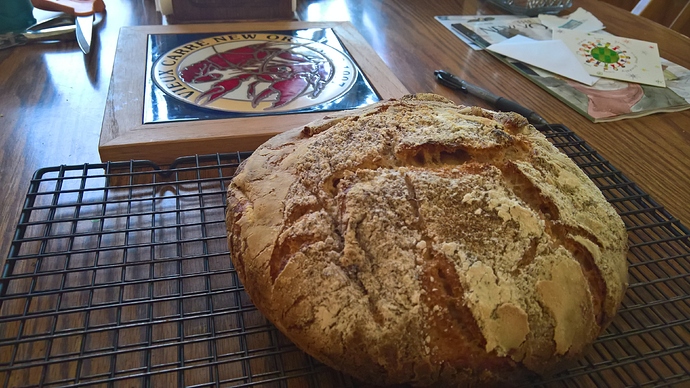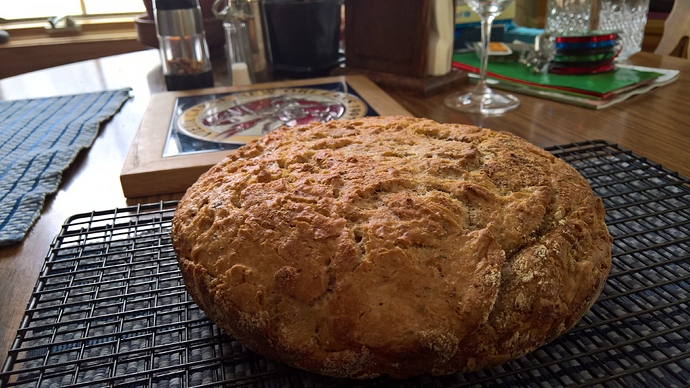THANK YOU After my first attempt with a different recipe failed (it rose sideways off the cookie sheet all over the oven ) this recipe and tutorial gave me back my confidence. I didn’t have any whole wheat flour, so I substituted 3/4 cup of roasted wheat germ. The smell and appearance are great. Thanks again
Just tried a new variation on this and it worked great and tasted great. I substituted Turkish Red Flour for the whole wheat and added 2 tsp of Rosemary and about 2/3 of a 5oz block of asiago cheese, finely grated, during the first mix. The last 1/3 of the asiago was sprinkled on the stretched dough prior to folding. With my stove and Lodge dutch oven, I had a little better bottom crust by lowering the temperatures by 25 degrees. This recipe makes a very savory loaf of bread. I am planning to serve it with a BBQ salmon dinner tonight.
The recipe does not specify what type of flour was used in the starter. The bread recipe has both white and wheat flour so do I need to have a starter with white and wheat flour in it or can I just use a whole wheat starter for this recipe? (New to sourdough). Thanks.
You do not need to match starter to recipe. I use an AP starter for everything. If you have and established whole wheat starter that is strong, it will be fine. Also if you have a strong white flour (All purpose/AP) flour, it will be fine as well.
Thank you!
You are welcome … post how it turns out for you … happy bread making 
My starter was just white wheat flour. It it’s healthy, it works fine with the Turkey red.
I have made several delicious sourdough loaves using recipes from the Breadtopia site. I baked a loaf of the no knead artisan sourdough today, The loaf tastes great and has a light, airy crumb. I am running into a problem with uncontrolled splitting of the crust even though I am scoring the loaf and cooking in the Emile Henry covered clay cooker. I welcome any advice that can help me make loaves that look as good as they taste!
Maybe slash more lengthwise than crosswise, kinda like you’d score a baguette only not so extreme. See the Ciril Hitz vid: https://breadtopia.com/store/bread-lame/
Just a guess.
Thanks, I’ll try that out. You have a great web site. I appreciate your direct and thorough videos and recipes!
I have to be the laziest baker anywhere. Sure, I use a scale to measure my flour and water, but I haven’t “proofed” the dough for years. I’ve mixed with 70 to 100% water:flour and never let a slack dough bother me. If the dough has risen to more than double, it’s ready! I was using a wetted large spoon to unload the dough from my fermenting bowl to the hot Dutch oven for baking–now I don’t even wet the spoon. I don’t slash the top either. Breads baked in a 9" Corningware casserole with lip handles and a round cover (two vents due to that mild mismatch) seem always to come out with a crack across the top. Breads baked in a Dutch oven have greater variability, likely related to water content. I’ve baked at 400, 450 and 500 degrees F.
Yeast or starter, this method seems so forgiving.
Bake. Eat. Love.
Alice, I baked it for 40 minutes covered at 475°F and 15 uncovered at 450°F
Hello,
I was reading the recipe and watching the video as well.
I suppose that has something controversial in the recipe above and in the video.
In the recipe is written that “Cover loosely with plastic and rest for 15 minutes.” The total time for the recipe is 18 hours.
In the video, 4:26, the man that is teaching how to make a Sourdough bread said that after we cover the dough with a plastic bag, we have to let the dough in the fermentation process for 18 hours.
Maybe I’m wrong.
Could you check please?
Thanks
Anyone try making an 100% whole wheat loaf using all freshly ground ww flour and adding gluten to the dough? That is how I make my regular (yeast) 100% ww bread and it turns out great. Not dense at all and very fluffy without any white flour. But never tried with sourdough. Any contraindications to adding gluten to sourdough?
Hello,
Have any of you tried this recipe in just a normal baking pan? I am new to baking and only have my wilton non stick loaf pans and glass pyrex. I am trying to learn how to make bread by hand because my mixer gave out on me yesterday. I need 5 loves a week and its a bit daunting to try and make it by hand… I end up with dough stuck all over me and it just a mess… Any tips? also will my pans work and do i need to alter anything in the recipe if i use them?
I’ve not tried baking in a loaf pan … and you might want to hunt up a no knead sandwich loaf recipe, but there is also this from thekitchn No knead sandwhich loaf hack.
You’ve no doubt thought of this and/or maybe have some limitation on hand mixing, but if you made smaller portions than 5 loaves worth of dough - your usual recipe, the hand mixing/kneading would be easier.
I will only make one loaf at a time by hand. I just am not sure what recipe to use. he makes it look so easy in the videos, I have a honey oat sour dough and a tomato basil sourdough i love but i feel it would be complicated without a mixer.
@lili and @tschiedeck
You might read these blogs to see lots of examples of different ways to go about things with whole grain flour, and stretching and folding, and no-kneading.
The breads in these blog posts don’t get mixed in stand mixers. You can always put dough in a loaf pan to cook it – just make sure not to overfill the pan, and go for a lower temperature than what a clay baker/dutch oven recipe would call for.
I’ve been making no-kneed bread for years, and this is my first try with the sourdough starter. This loaf, like almost all of my previous loaves, came out small and flat.
I get great rise overnight - it doubles or triples in size overnight. But then I fold it over and let it sit for 15 minutes under plastic, and then make a ball and then wrap in a floured towel to rise for another 1.5-2 hours.
It NEVER rises this second time. Ever.
I put it in to bake about the same size as the ball I left after folding it over, and I get a small, dense loaf.
What is going wrong here? I followed the directions exactly, as always.
What causes the second rise? Heat? Humidity? Should I change the environmental conditions (if possible)?
I always get a great primary rise, and never get any secondary rise, and always end up with a flat, dense disappointment.
Help!
@bpbpthomas, Off the top of my head I think it’s a distinct possibility that your dough is over-proofing during its first rise. If it’s more than doubling, indeed tripling, it’s used up all its rising power in that first proof. It simply has no more oomph to rise anymore or to give a good oven spring when baking. Something you might try would be to prepare your dough earlier in the day and place the covered bowl immediately into the refrigerator until much later at night, at bedtime, before placing the covered bowl on the counter to rise. The cold temperature of the refrigerator will slow down the rising action of the sourdough without stopping it. It’ll just slow it down. It will take a bit longer for your dough to warm up to room temperature coming right out of the refrigerator. That in itself will buy you a bit more time overnight. After the folding and 15-minute wait, let your dough be your guide when doing the secondary rise in the basket. One to two hours may simply be too long. IF your dough is already over proofed, giving it more time to rise in the basket will simply be ineffective. IF your dough does rise a bit during the fold and 15-minute wait, definitely watch how long you let the dough rise in the basket. You might consider checking its progress after about 35-40 minutes. If the dough has risen a good bit then it’s actually better to bake at that point then to risk over proofing. Baking when the starter is still viable will be what gives you a good oven spring (rise in the oven when baking). Something else to consider is how you’re baking your bread. Ideally, using a cloche, Dutch oven or covered clay baker will give your dough something to shape to during baking. It helps with the final oven spring, rise and shape of the loaf. Preheat your oven with your cloche, Dutch oven or covered clay baker inside for at least 30 minutes so that it’s at optimum baking temperature. I hope that these suggestions are helpful; any one of which may just be the ticket to successful bread baking. Keep trying! Keep baking. You’ll be glad you did. Almost forgot…using freshly fed starter is also a great help. Feed your starter about 7 hours or so before using it. A freshly fed starter is a happy active starter.
Leah

